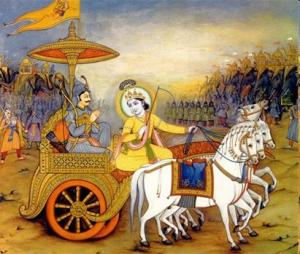The Bhagavad Gita is the ultimate book of knowledge and is duly recognized as such throughout the world. Its wisdom transcends the limits of time and space. I publish daily one message from the book which can be related to our daily life titled: Thought4TheDay
These are widely read and highly appreciated by my connections on LinkedIn, friends on Facebook and followers on twitter totally about 27000 people. As recommended by some friends, I am posting the same here. You may ask questions and/or post your comments which be appreciated. Hope you will find the initiative very rewarding.
Thought4TheDay (21.9.2017)

“The person who has controlled his mind, and gets endowed with the purity of thoughts, his ‘atma’ (soul) is no less than Almighty, as he is the embodiment of atma in all beings; Such a karamyogi carries on performing his duties without attachment”.
“The man of wisdom, Sankhyayogi; when he touches or when he smells; when he speaks or he listens; when he eats or walks or sleeps or breathes; when he relinquishes or receives, and even when he closes his eyes or opens them, when he walks or sits, considers that all his senses carry on with their functions. He thinks that he, in fact, is not doing anything whatsoever.”
Thus the person who has dedicated all his actions to the Almighty (society, or humanity at large) gets rid of attachments of all kinds and performs his duty peacefully. He is like a lotus flower in muddy waters and doesn’t get affected by sins of any kind. When the focus is just on doing what you are doing, the performance would be at par excellence,undoubtedly.
Thought4TheDay (20.9.2017)

A man is his own enemy or he can be his own friend. The difference happens according to his ability to give himself a direction befitting someone who wants to understand his higher self. Or he is just swayed by the wayward actions of his body due to inability to control mind and senses. Even when he knows that temptations are not good for him, yet he is compulsively drawn towards these sensory gratifications due to lack of self control. In such circumstances, the man is his own enemy.
The person who bears no agitation or attachment in pleasure or in pain, in summer or in rain or winter, in fact, pursues the right path of life. He is not affected by respect or disrespect by others due to their own lack of understanding of life. Such a person is his own friend.
His ‘atma’ (soul) has attained self realised freedom, and his mind is always creatively engaged in the Almighty. His wisdom teaches him that nothing is really as important as Almighty, the Lord.
Please share this post with your friends for greater awareness, should you like it. Thanks.
Category: Personality development
The Bhagavad Gita Talks 7
The Bhagavad Gita is the ultimate book of knowledge and is duly recognized as such throughout the world. Its wisdom transcends the limits of time and space. I publish daily one message from the book which can be related to our daily life titled: Thought4TheDay
These are widely read and highly appreciated by my connections on LinkedIn, friends on Facebook and followers on twitter totally about 27000 people. As recommended by some friends, I am posting the same here. You may ask questions and/or post your comments which be appreciated. Hope you will find the initiative very rewarding.
Thought4TheDay (19.09.2017)
 Through the meditative technique which is described as follows, the practitioner can focus his attention and control his mind. He should fix mindfulness by thinking and visualising his gaze in the middle of eyes on his forehead.
Through the meditative technique which is described as follows, the practitioner can focus his attention and control his mind. He should fix mindfulness by thinking and visualising his gaze in the middle of eyes on his forehead.
This will enable him to be rid of thinking of worldly objects. So, focusing mind in the middle of forehead, practitioner has to observe his breathing in and breathing out. The process of inhaling and exhaling of breath, then, needs to be equated. It means the same measure of breath should be inhaled and exhaled in equal duration. When it is achieved, the practitioner should meditate on God the Almighty, the all pervading being. Eventually, he develops his ability to perceive oneness with The Lord.
In this manner, the selfless person will be able to realise that there is nothings more important than his presence in Lord the Almighty and presence of the Lord in him. There remains nothing for him which is more precious when compared to his experience. With this practice, he achieves highest form of peace, which is a far cry for humans attached and engaged in the worldly affairs, trying to fulfil their wishes and desires, which are all so short lived.
Thought4TheDay (18.09.2017)
 It is recommended that some time one must spend alone during the day. These moments need to be spent on contemplating one’s own place or status in reference to life’s vision one has defined and the mission and the goals set.
It is recommended that some time one must spend alone during the day. These moments need to be spent on contemplating one’s own place or status in reference to life’s vision one has defined and the mission and the goals set.
Lord Krishna says, “The person who decisively listens to his soul and not his senses, who comforts with not what he has achieved in respect of material possessions, but who discovers joy in the good deeds carried out as devotion towards ‘ME’ for the good of the society is happy and truly wise.
The person who finds his happiness only in his own atma (soul) and dwells in his atma, guided by his atma can alone experience oneness with ‘ME’ the all pervading, all powerful Almighty Lord. With such matchless position, he attains peace and tranquility.”
Please share this post with your friends for greater awareness, should you like it. Thanks.
The Bhagavad Gita Talks 6
The Bhagavad Gita is the ultimate book of knowledge and is duly recognized as such throughout the world. Its wisdom transcends the limits of time and space. I publish daily one message from the book which can be related to our daily life titled: Thought4TheDay
These are widely read and highly appreciated by my connections on LinkedIn, friends on Facebook and followers on twitter totally about 27000 people. As recommended by some friends, I am posting the same here. You may ask questions and/or post your comments which be appreciated. Hope you will find the initiative very rewarding.
Thought4TheDay (16.09.2017)
 Lord Krishnaexplained to Arjuna in response to his question whether renunciation of work is better or working with devotion is superior.
Lord Krishnaexplained to Arjuna in response to his question whether renunciation of work is better or working with devotion is superior.
According to Lord Krishna Karamsanyas yoga, in other words yoga of renunciation of work is difficult for human beings.
It is difficult to eradicate ego from whatever efforts one makes. It is difficult to carry out .your duty believing at the same time that you are not the doer.
Your work, in any case, you have to do and you must do it to the best of your ability.
As compared to renunciation of work, carrying out your duty with devotion is easier. Here, you are not expecting any personal reward or fruit of the efforts. You are not expecting any profit. You are not acting because of any selfish motive. You are dedicating your efforts to ‘ME’ said the Lord. In fact, you are dedicating your efforts to the humanity. Because as I said earlier all beings, living beings are parts of ‘Mine’. So, any efforts.of yours if these are bringing good to the society; these are in reality serving ‘ME’.
Therefore, for us the common people, doing our work without selfish motive, or for the good of society or Karmayoga is a path we need to follow.
Thought4TheDay (05.09.2017)
 Actions are the results of the 3 human ‘gunas’ or tendencies and their interaction in the human mind. These three attributes are: Satva, Rajas and Tamas. At different times one or the other dominates overpowering the remaining two. Each of these are responsible for particular activity or inactivity.
Actions are the results of the 3 human ‘gunas’ or tendencies and their interaction in the human mind. These three attributes are: Satva, Rajas and Tamas. At different times one or the other dominates overpowering the remaining two. Each of these are responsible for particular activity or inactivity.
Satva, when in power, motivates the individual to engage in spirituality, charitable activities, gratitude, compassion, devotion to God etc.
Likewise, when ‘Rajas’ is prominent, the person becomes engaged in physical endeavours. Material desires take charge of him. At such moments, Satva tendencies are subdued. Such times are replete with human emotions. Happiness, anguish, sufferings, exhilarations etc. dominate life.
But when ‘Tamas’ dominates, the person becomes victim of laziness, indolence, dunes of mind, feeling of helplessness, negativity, pessimism etc.
Please share this post with your friends for greater awareness, should you like it. Thanks.
The Bhagavad Gita Talks 5
The Bhagavad Gita is the ultimate book of knowledge and is duly recognized as such throughout the world. Its wisdom transcends the limits of time and space. I publish daily one message from the book which can be related to our daily life titled: Thought4TheDay
These are widely read and highly appreciated by my connections on LinkedIn, friends on Facebook and followers on twitter totally about 27000 people. As recommended by some friends, I am posting the same here. You may ask questions and/or post your comments which be appreciated. Hope you will find the initiative very rewarding.
Thought4TheDay (15.09.2017)
The ignorant individual is full of doubts. Having no faith, he always remains below sword of fear. Fear also leads to indecision which acts as a handicap in performance. The person who pursues material objects becomes a victim of multifaceted fear. Whether he will achieve the object that he desired or not disturbs him all the time. Ignorance and peace and he remains under stress.
But according to Lord Krishna the individual who has achieved the transcendental knowledge rises all the materialistic desires. It is doubts are demolished completely.
Said Lord Krishna, “Therefore, the doubts which have come to your mind out of ignorance must be killed with the sword of knowledge. These armed with confidence and knowledge stand up and fight the battle.

Thought4TheDay (06.09.2017)
One should not be swayed away by the feelings of attraction or repulsion. These emotions are rooted in all sense objects. When these are not controlled, these emotions act as enemies and don’t allow the individual to grow. They act as hurdles in the path of man’s redemption.
One should never breed a longing for doing someone else’s job because it is more likeable. Your own work may not have glamour or merit or status, yet it is the best job for you. Performing your own duty well brings you blessings and peace and must be appreciated as such. Wanting to be someone else is unbecoming and fraught with fear.
Please share this post with your friends for greater awareness, should you like it. Thanks.
The Bhagwad Gita Talks 4
The Bhagavad Gita Talks 4
The Bhagavad Gita is the ultimate book of knowledge and is duly recognized as such throughout the world. Its wisdom transcends the limits of time and space. I publish daily one message from the book which can be related to our daily life titled: Thought 4 The Day.
These are widely read and highly appreciated by my connections on LinkedIn, friends on Facebook and followers on twitter totally about 27000 people. As recommended by some friends, I am posting the same here. You may ask questions and/or post your comments which be appreciated. Hope you will find the initiative very rewarding.

Thought 4 The Day (14.09.2017)
Right knowledge of self and the relationship with the Lord Almighty creates within the seeker that fire which can burn away the darkness of doubt, lack of faith and ignorance. The situations happen unexpectedly. There is little control an individual can have over what might happen. But how you react to these situations and/or circumstances is an area where you can exercise your control. Partly it depends on your attitude and partly on the knowledge that you may have acquired. Your attitude is formed over the years due to various influences. You acquire knowledge from your Guru or mentor or with your own efforts. Knowledge which is not followed by appropriate action loses its significance or even power. One should never allow that to happen.
We find from The Bhagavad Gita that whatever Lord Krishna explains to Arjuna eventually leads to one principle of life; follow the path of your duty selflessly under all circumstances.
Thought 4 The Day (07.09.2017)
Knowledge is covered by it’s adversary which is desire. Desire spreads like fire if not kept under control. Senses, mind and intellect are places of it’s sojourn. Often the desire with it’s evil designs deludes the soul. It is, therefore, necessary to curb it and keep it restrained.
Senses are greater than the body; mind can be stronger than the senses; intellect is more powerful than the mind and what is higher than the intellect is one’s soul. Knowing this, one must kill the enemy in the garb of desire.
Please share this post with your friends for greater awareness, should you like it. Thanks.
The Bhagavad Gita Talks 3
The Bhagavad Gita is the ultimate book of knowledge and is duly recognized as such throughout the world. Its wisdom transcends the limits of time and space. I publish daily one message from the book which can be related to our daily life titled: Thought4TheDay
These are widely read and highly appreciated by my connections on LinkedIn, friends on Facebook and followers on twitter totally about 27000 people. As recommended by some friends, I am posting the same here. You may ask questions and/or post your comments which be appreciated. Hope you will find the initiative very rewarding.
Thought4TheDay (13.09.2017)

The importance of a teacher or a guru or mentor should never be undermined in this life, according to The Bhagavad Gita.
We need to learn the truth of life and be guided by our mentor at every stage of our life. Choose a knowledgeable mentor. Be humble to him, but ask him any question that may arise in your mind during the journey of your life. Clear all your doubts. The self realized soul (your guru), who has experienced the truth will impart all knowledge to you.
“When you have learnt the truth or known life in the real sense, you will see that all living beings are but a part of Me (an Ansh, maybe a drop in the ocean). In fact I am the ‘whole’ of the living souls. When you have acquired such knowledge of ‘self’, you will find that neither any worldly difficulty nor any challenge can deter you from your mission; no pursuit of futile material pleasures will tempt you away from your path of righteousness,” said the Lord.
All the sins stand burnt away by the purging fire of the transcendental knowledge, according to Lord Krishna.
Thought4TheDay (08.09.2017)
Lord the Almighty, God is always present everywhere. Such an awareness keeps us blessed, and also keeps us motivated.
Whenever righteousness is overpowered by the evil, Lord manifests in bodily form. The world is a battleground where Evil and Good are always fighting each other. They are invariably on a warpath. It’s only at a time when righteousness diminishes though never extinct, Lord appears to correct the balance. Undoubtedly the birth and activities of the Lord are divine and beyond the compression of an ordinary human being. Just its awareness helps us to choose the path of righteousness and maintain our peace.
History tells us that whenever there is excess of anything, change emerges in the form of a revolution to bring back the balance.
We also find that with the passage of time and many generations the strong becomes weak and the weak becomes strong. This is true for families, communities, societies and even countries.
Please share this post with your friends for greater awareness, should you like it. Thanks.
The Bhagavad Gita Talks 2
The Bhagavad Gita is the ultimate book of knowledge and is duly recognized as such throughout the world. Its wisdom transcends the limits of time and space. I publish daily one message from the book which can be related to our daily life titled: Thought4TheDay
These are widely read and highly appreciated by my connections on LinkedIn, friends on Facebook and followers on twitter totally about 27000 people. As recommended by some friends, I am posting the same here. You may ask questions and/or post your comments which be appreciated. Hope you will find the initiative very rewarding.
Thought4TheDay (12.09.2017)
 Lord Krishna explains that the Karmayogi detaches himself from the petty worldly affairs. Devoted to the performance of his own duty, he remains satisfied with what he receives in return. Such an attitude enhances the efficacy of his actions. He transcends the petty pangs of the elemental human emotions like joy, grief, worry, uncertainty etc. These do not detract him from the path of performance of his duty. He remains balanced in success or failure like a scientist who keeps on acquiring knowledge from the study of cause and effects. His is a free soul which is not restricted by the perceived limitations.
Lord Krishna explains that the Karmayogi detaches himself from the petty worldly affairs. Devoted to the performance of his own duty, he remains satisfied with what he receives in return. Such an attitude enhances the efficacy of his actions. He transcends the petty pangs of the elemental human emotions like joy, grief, worry, uncertainty etc. These do not detract him from the path of performance of his duty. He remains balanced in success or failure like a scientist who keeps on acquiring knowledge from the study of cause and effects. His is a free soul which is not restricted by the perceived limitations.
Further, he rises above the pettiness of ego and doesn’t claim anything as his own. His mind finds solace in the knowledge of ‘self’. All his efforts are directed towards the cause of upliftment of society as he discovers peace and happiness in such endeavours.
Thought4TheDay (09.09.2017)
 Lord Krishna, “Whatever actions and whichever way a nobleman performs his duty; the example is followed by the common man. I this manner, certain standards are set on the basis of which ordinary human beings carry out their work. The noble person leads others by example.
Lord Krishna, “Whatever actions and whichever way a nobleman performs his duty; the example is followed by the common man. I this manner, certain standards are set on the basis of which ordinary human beings carry out their work. The noble person leads others by example.
There is no duty prescribed for me. There is nothing in the world that I need. Yet, I am engaged in work. If I don’t do any work, human beings will follow my example. They will also not do anything. In such a situation, when nobody works, the world will be ruined. Therefore, even for Me performance is necessary. If there are no jobs for the people in the world, can there be any peace?
In such circumstances, while the ignorant, who lacks real knowledge, performs his duty with attachment to the results, the enlightened person should be engaged in performance of his duty without any attachment to the results. He should set an example for others to follow.”
Please share this post with your friends for greater awareness, should you like it. Thanks.
The Bhagavad Gita Talks
The Bhagavad Gita is the ultimate book of knowledge and is duly recognized as such throughout the world. Its wisdom transcends the limits of time and space. I publish daily one message from the book which can be related to our daily life titled: Thought4TheDay
These are widely read and highly appreciated by my connections on LinkedIn, friends on Facebook and followers on twitter totally about 27000 people. As recommended by some friends, I am posting the same here. You may ask questions and/or post your comments which be appreciated. Hope you will find the initiative very rewarding.
Thought4TheDay (10.09.2017)

In the first chapter of The Bhagavad Gita, Arjun overwhelmingly tells Lord Krishna that he doesn’t want to fight with his own relatives. He philosophises his decision putting forth imagined arguments like it is not good for their larger family and not in the interest of humanity.
In the second chapter Lord Krishna describes qualities of and differences between ‘Karmayoga’ and ‘Sankhyayoga’ and also the characteristics of ‘Stithpragya purush’ or stable minded person.
In the third chapter the Lord talks about ‘Karmayoga’ and why Arjuna should follow the path of ‘Karmayoga’.
Arjuna, who considered Krishna his dear friend, a relative and a guide is quite surprised at the way Krishna talks to him with conviction and authority. When the Lord told him that He had imparted this sacred knowledge to the sun-God, Vivasvan, Arjuna asked Lord Krishna:
Arjuna, “You have said that you imparted this transcendental knowledge to the sun-god, Vivasavan, who in turn passed it on to Manu, the father of mankind. But Vivasvan was born ages ago. How could you have advised Vivasvan in the circumstances?”
Lord Krishna answered, “Arjuna, both you and I had many births earlier. While I remember them, you cannot.”
Thought4TheDay (11.09.2017)

Lord Krishna explained to Arjuna that in ancient times people who were seeking liberation were performing their duties. Just as those wise men, Arjun should also, following their example, carry out his work.
Further, Lord Krishna said, “What is action and what is inaction is a question that has bewildered even the intelligent and the wise. Let me explain the facts regarding action and inaction. Inaction in this context is not lack of action due to laziness or any other reason.
Inaction here simply means lack of your expectations from your efforts. Without expecting if a person performs his duty; it amounts to inaction in his action. This is desirable.
Action in inaction means that your nonperformance is deliberate as you find it best for the occasion. Your inaction is because of your decision which you have taken due to some reasons.”
Please share this post with your friends for greater awareness, should you like it. Thanks.
11 tearing elements of Negative attitude!

It is necessary to identify the negativity in your attitude. What is negative attitude? Negative attitude is when you start focusing on the problems that you might face during your efforts to achieve your goals. It is the lack of hope that things will happen to help you out in your mission. It is the feeling that people will not help you because on earlier occasions you met with rejections. Negative attitude is the lack of your conviction that you can overcome the hurdles that you might face during your journey. In a sense, negative attitude is also a lack of belief in you. Some more symptoms of negative attitude are enumerated below:
- Laziness: When you think you don’t have the energy to get up and do the work. Sometimes you don’t even think and realize that laziness is simply whiling away the time. It is not even procrastination which will be described separately.
- Low self esteem: It is an extremely harmful attribute in your personality. You start thinking that you are good for nothing. You accept the situations in which you are because your self esteem is so low that you think you can do nothing better.
- Low productivity: Work has a strange tendency of expanding as per the time available. Even worse is when no time is allotted for the completion of a task. This gives you a feeling of solving certain important problems whereas in fact you are just being satisfied in remaining busy. This approach will never allow you to increase your productivity. For doing more in a given time, you have to stretch yourself. Therefore is it necessary that you allot specific time duration for a task. In the beginning, the allocation may seem difficult, but once you form a habit it will become much easier. Difficult or easy, it is necessary.
- Lack of initiative: For any significant progress, initiative is necessary. What is initiative? Initiative is your first step for going ahead with a task. When it is something new, you have to creatively think and courageously take the first step, even if there is some risk. No risk is the biggest risk in life. Any significant initiative cannot be taken to move forward without accepting this reality. So don’t be afraid to take initiative.
- Not listening to understand: In the course of conversations, sometimes we tend to focus so much on what we have to say, that we stop listening to the other person. This is particularly so when the speaker has said something for which we have a ready argument to negate what he has said. Unfortunately, such a habit does not allow us to listen and assimilate what the speaker says after that. Evidently it leads to miscommunication and problems. The solution is first understand and then be understood.
- Faking: We feel envious of some people who are more successful in the material sense than we think that they deserve. Such a feeling leads us to a myth that it is their style which makes them successful and we try to imitate their conduct. This is a extremely bad situation. We lose belief in ourselves, and how can we expect that others will believe us.
- Not trying to express: When we have certain ideas, but either we do not want to express, or we are afraid to express, is also indicative of our negative attitude. It is necessary to develop an ability to express without hesitation. The fear of rejection which takes away your ability to act is one of the serious handicaps.
- Not learning lessons from mistakes: There is no one who does not commit mistakes. Whenever we undertake something new, mistakes may happen. This is normal. However, repeating the same mistake again and again, is neither normal, nor should be acceptable. Thus we must learn lessons from our past mistakes and use these lessons to direct our future efforts.
- Ego: Ego happens to be another aspect of personality which does not allow us to grow. Ego comes in the way of our approaching people to help us. It makes us believe that it is below our dignity to seek help. A success Guru had said that there are eleven principles of achieving success. And what are these eleven principles? These are, ask, ask, ask….(eleven times).
- Jealousy: Jealousy is a negative emotion which keeps sapping our creative energies. We gain nothing in the process. It makes us feel as victims of fate or poor destiny. Jealousy may even take away our sound sleep. The worst part is that sometimes it cannot be contained, it goes on swelling. Jealousy must be thwarted out of the personality.
- Avoiding hard work: There is only one way to success, and that is the hard way. If we habitually seek short cuts it will be very difficult for us to work hard. What is working hard? When you are fully devoted to completing the job and you forget even your surroundings, you continue to work even when you are tired because you want to complete. That aspect of work may be termed as hard work. Initially it may be very difficult, but then one can form a habit. For any significant progress, hard work is necessary.
Thanks for reading.
Who will bell-The Grammar Cat

When we are asked to stand up and speak, we tend to run out of words; sometimes ideas too; even though we have already prepared. The stage fright is often a common occurrence.
When we sit to write, we feel like timid mice in presence of a ferocious Grammar Cat. When we know the subject there is no reason whatsoever that we should not be in a position to sit down and write @ 20 words per minute, faster if you type.
We don’t have to do all the grammar exercises that scared us during our school days. But we definitely have to brush up tenses, auxiliaries & modals, prepositions, articles etc. Not a tall order; just a few hours of serious work.
How it will help? You will be able to express yourself clearly, effectively and more importantly in a style that is appreciated because it is easy to understand. And then, there are FOUR simple rules to follow:
- Choose nouns over adjectives. Nouns give you the crisp information. Adjectives make the reader wonder. In our written communication, our objective should be ‘the ease of business’; If it’s a businessman, he doesn’t want any unnecessary hurdles, and so the reader would not like to face any hurdles in understanding your message.
- Choose verbs over adverbs. Verbs are giving information about the actual action, while adverbs describe the quality of action. For example instead saying “he went to the hospital quickly” it will be more effective to say, “He rushed to the hospital”.
- You can make your message more effective by using specific words instead of general words. Instead of saying, “ I will call you next week about this problem,” say “I will call you on Thursday (or any other day) afternoon about request by Ramesh for transfer.”
- Choose short sentences instead of the long ones. But vary the length of the sentences. Otherwise it will appear boring.
You can easily follow the above simple precepts to make your communication natural, precise and interesting only when you have belled the Grammar Cat.
Thanks for reading.